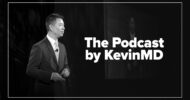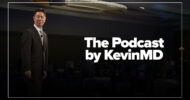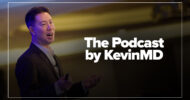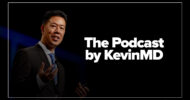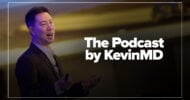Subscribe to The Podcast by KevinMD. Watch on YouTube. Catch up on old episodes!
In this episode, nurse consultant Beth Boynton joins us to discuss the transformative power of the Medical Improv Toolkit in clinical settings. We dive into how playful, experiential activities can enhance communication, reduce conflict, and foster psychological safety among healthcare teams. Beth shares how these simple yet powerful tools can be seamlessly integrated into meetings and daily routines, creating long-lasting improvements in teamwork and collaboration.
Beth Boynton is a nurse consultant.
She discusses the KevinMD article, “Transform your health care team with these 5-minute communication exercises.”
Our presenting sponsor is DAX Copilot by Microsoft.
Do you spend more time on administrative tasks like clinical documentation than you do with patients? You’re not alone. Clinicians report spending up to two hours on administrative tasks for each hour of patient care. Microsoft is committed to helping clinicians restore the balance with DAX Copilot, an AI-powered, voice-enabled solution that automates clinical documentation and workflows.
70 percent of physicians who use DAX Copilot say it improves their work-life balance while reducing feelings of burnout and fatigue. Patients love it too! 93 percent of patients say their physician is more personable and conversational, and 75 percent of physicians say it improves patient experiences.
Help restore your work-life balance with DAX Copilot, your AI assistant for automated clinical documentation and workflows.
VISIT SPONSOR → https://aka.ms/kevinmd
SUBSCRIBE TO THE PODCAST → https://kevinmd.com/podcast
RECOMMENDED BY KEVINMD → https://kevinmd.com/recommended
GET CME FOR THIS EPISODE → https://kevinmd.com/cme
I’m partnering with Learner+ to offer clinicians access to an AI-powered reflective portfolio that rewards CME/CE credits from meaningful reflections. Find out more: https://kevinmd.com/learnerplus
Transcript
Kevin Pho: Hi, and welcome to the show. Subscribe at KevinMD.com/podcast. Today, we welcome back Beth Boynton. She’s a nurse consultant and she’s the author of the book, The Medical Improv Toolkit: 10 Simple Activities to Promote Safe Care, Healthy Workplaces, and Rewarding Careers. There’s an excerpt from that book on KevinMD.
Transform your health care team with these five-minute communication exercises. Beth, welcome back to the show.
Beth Boynton: Hi, Kevin. Thank you. Hi, everybody. It’s nice to be back talking with you.
Kevin Pho: All right, so before talking about your excerpt, what led you to submit this particular one to KevinMD?
Beth Boynton: Well, I, I knew that there was approximately a thousand-word framework to come up with something from this book that would give people a good idea about what it’s about and why it’s important. And so this excerpt is pretty much the entirety of a chapter—chapter four—which is part of the first point of the book that goes into the how and why of medical improv. This chapter is about the vision. So it’s preceded by, you know, health care interactions are important—that’s chapter one. Changing behavior is hard—that’s chapter two. Medical improv is a teaching modality. And then this chapter, which is the vision of this book, kind of capsulizes all of it without going into the actual 10 activities.
Kevin Pho: All right, so tell us about this excerpt for those who haven’t had a chance to read it.
Beth Boynton: Yeah, well, you know, I, I’ve been teaching soft skills in health care as a nurse consultant for almost two decades. And I’ve been playing with, experimenting with integrating simple improv activities into those workshops—like workshops on speaking up, giving and receiving feedback, emotional intelligence. And what I’ve discovered over the years is what really works best is when you take the more traditional learning methods of a lecture and maybe a PowerPoint and a handout and you integrate them with activities from improv because they’re so experiential.
And the more I see how powerful these experiences are when I’m working with health care teams or students or faculty, it’s like, I want to be able to give other health care leaders the tools so they can teach them. You do need a little bit of understanding about improv and “yes, and,” but you don’t need to be an expert. They’re so powerful. If health care leaders and managers can get a hold of a few, they can start to integrate them into meetings they already have—you know, grand rounds, you can spend five minutes in grand rounds or human resources, or, you know, a retreat. You can integrate them into just about anything else you’re doing. And so then you’re always building the skills and also maybe having a little bit of fun, which isn’t a bad thing.
Kevin Pho: So give us examples of some playful activities that could be integrated into busy clinical settings.
Beth Boynton: Sure. Well, so I would integrate them into the meeting. So, for instance, in one of the chapters, there’s an activity called “adjective name gesture.” To simply explain the activity, it’s just in a circle. You go around, and you say your name with some sort of an adjective that begins with the same letter and some sort of gesture. And then everybody mirrors it back. So I might say, “I’m Boisterous Beth,” and then you and everybody else would have to mirror that back.
So the way I integrated in a case scenario—which there are visionary case scenarios in each of the activities—rehab during a nursing clinic where they’re at a rehab hospital. So there’s the rehab instructor. And what that instructor says is that what we’re going to do is we’re going to integrate these activities into our clinical experience, not with patients, but in our pre- and post-meetings. So they go around, they do that activity. He does it twice. And so then he starts to notice that the second time around, everybody is a little bit more vocal. They’re a little bit more comfortable speaking up, which we know is critical in health care. And so then it goes on to help. So everybody’s voice is heard in that situation. Then later on in the scenario, one of the students decides to teach and work with one of her patients in the rehab unit, and he says he’s Vivacious Vic, and Vivacious Vic raises his arm and actually, I bring it back to a clinical experience where the range of motion is actually improved. So that’s something I made up. I don’t want to present that as an evidence-based situation, but it’s to give people an idea of how they can integrate the activity.
Kevin Pho: Do you find it challenging when you talk to these health care organizations to incorporate some of these improv-based skills into their meetings or retreats?
Beth Boynton: Yes, it’s, you know, it’s, I think it’s, there’s a lot of challenges around bringing this work into the field. And in this chapter, I talk about six of them. You know, one of the challenges is that the activities require a little bit of emotional risk. You know, we’re talking about changing behavior, and speaking up or listening can be challenging a little bit for everybody, so that’s a challenge. Another stress is that, to learn these skills in the clinical environment with this almost relentless nonstop pressure—what we can do by taking five or ten minutes out of that clinical environment and removing the pressure to perform clinically is to get a little bit more playful and a little bit more comfortable with taking the risk. And once we take the risk, it’s a little bit easier the next time.
You know, another challenge to teaching these kinds of skills is that people are at different places. You know, I might be more comfortable as a listener and good at that skill, but I might not be as confident about sharing ideas or concerns. Somebody else in an activity might be more comfortable speaking up but not as good at listening. And so when we do an activity together, one of the elegant parts of it is that I get to practice my speaking up and developing my confidence while the person that I’m working with is actually practicing listening. And so we end up teaching each other. It’s a really elegant design for developing the social kinds of skills that help us.
And I think a lot of the work in health care, when we approach communication or other kinds of soft skills, is that going to one workshop and then not going to another one for a year is not all that effective. It probably helps some, depending on the workshop, but we really need to practice them. And so if health care leaders get these simple activities and can get them going with their teams, they’ll be creating social opportunities for those people to practice those skills. They go out into the clinical environment, they have an experience where they practice it, they get some feedback. For instance, in a typical “yes and/yes but,” I think you and I have talked about this before, I might gain an awareness of what it feels like when somebody “yes buts” me, or I might become aware that I am saying “yes, but” a lot. So I get the awareness and the activity, and then I go out into my life and my work, and I find that, oh, I notice I say “yes, but.” So then I reframe it, and I get a different reaction. I get the feedback, and it’s a more open conversation, so then I can integrate it more. So basically, what I’m saying is, like, changing behavior is hard, and we need a chance to practice it, you know, get feedback, and try it again.
Kevin Pho: You mentioned earlier that some of these activities require emotional risk and that some members of the staff may be more amenable to taking that risk than others. So how do you overcome that obstacle? How do you get people who are a little bit more hesitant to risk themselves emotionally to participate in these exercises?
Beth Boynton: That’s a really important question and fundamental to this book with the facilitation tips for each of the activities, some of which I’ve learned over time by practicing. For example, in that activity, I’ve been in groups where I can see visually that somebody is really struggling to have a physical expression or say something, because it’s not something we’re used to doing in health care. So I’ve learned to do things differently. I might say, depending on the group and my sense of who might be struggling, who might be more timid, or who might be a little bit more dominating, I might position myself in a circle and say, “All right, let’s do one with just the adjective and the name. Forget about the physical gesture.” That makes it easier. I say in the book that I can’t take the risk away, but I can make it safe enough to try. And I can help other health care leaders who want to champion this kind of work learn.
That’s what makes the big difference between just doing a silly activity and facilitating it in a way that is as safe as possible for everybody.
Kevin Pho: Tell us about a successful case study or story where an organization implemented some of your techniques and really moved the needle to appreciable outcomes.
Beth Boynton: Well, that is a challenging question, and I’m going to answer it the best way that I can by just sharing an experience that I just had at SUNY Corning, where I was presenting to nursing faculty and students and theater faculty and students. One of the senior leaders in this workshop thought, “Wow, this would be a really great experience.” It was the “radical acceptance” activity, where people name something, and everybody says “yes” to it. You do it in the room, and you can see how visceral it can feel for people to be affirmed by others, creating an opportunity for that connection.
Her plan was to try it with her nurse faculty, but she was a little apprehensive the next morning. I gave her a copy of the book and hoped she would read the facilitation tips. It’s similar to when health care leaders do something for the first time in their clinical world, like writing a prescription or giving an injection—it can be scary, but you do it. For this teaching method, leaders could say, “This is the first time I’m teaching this, and it feels awkward, but I hope you’ll help me by participating.”
Taking that risk shows your humanity, and it becomes easier with experience. It also builds empathy for the hesitant participants. A successful story related to this is from Esther Waterhouse, a UK physician and palliative care leader who directs Medical Improv Great Britain. She tried the “radical acceptance” activity in a meeting and admitted it felt risky, but the feedback was positive. People enjoyed it and even wanted to do it again. Sometimes, you just need to leap, and the net will appear.
Kevin Pho: Beth Boynton is a nurse consultant and author of The Medical Improv Toolkit: 10 Simple Activities to Promote Safe Care, Healthy Workplaces, and Rewarding Careers. Beth, who is the audience for your book? Who is the ideal person that you want this book to help the most?
Beth Boynton: The ideal audience is anyone in a leadership position in health care who works with or interfaces with health care teams. That includes physicians, nurse leaders, managers, and even management teams. Emerging leaders with an interest in teaching or incorporating soft skills into their team’s development will find this resource useful. Endorsements for the book come from both nurse and physician leaders. Dr. Mike Smith, a physician in Nebraska who also teaches improv, wrote the foreword, showcasing the interdisciplinary appeal of this work.
Kevin Pho: What are some take-home messages you want to leave with the KevinMD audience?
Beth Boynton: Thank you, Kevin. The activities themselves—all 10 of them—are fairly simple intellectually but offer powerful social and emotional learning opportunities. If you understand and apply the facilitation tips I mentioned, you can teach them effectively. The book also provides access to video clips, most under one minute, to show what these activities look like. While the activities are simple, the facilitation is essential, and the individual, team, and organizational learning from them can be transformative.
Kevin Pho: Beth, thank you so much for sharing your perspective and insight. Thanks again for coming back on the show.
Beth Boynton: Thank you, Kevin. It’s always nice to see you. Thanks, everybody.









